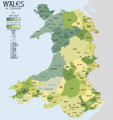Welsh Marches facts for kids
The Welsh Marches is a special area. It is found around the border between England and Wales. This border has changed many times over history. Because of this, some towns have been in England at one time and in Wales at another.
Contents
What are the Welsh Marches?
The Welsh Marches is not a clearly defined place. It is simply the land near the line that separates England and Wales. This border has moved back and forth many times. So, towns in this area have often switched between being part of England or part of Wales.
Early History and Defenses
On the English side of this area, there was once a powerful kingdom called Mercia. The kings of Mercia built large earth walls. These walls were called Wat's Dyke and Offa's Dyke. They were built to mark and defend the border. Important market towns on the English side, like Shrewsbury and Hereford, had soldiers stationed there to protect them.
Norman Lords and Castles
The name "March of Wales" was first used in a very old book called the Domesday Book in 1086. Over the next 400 years, rulers from Normandy (in France) set up special areas. These areas were given to powerful noblemen called "Marcher Lords." Their job was to patrol and protect the borderlands.
Many small castles were built in the border area during the 1100s and 1200s. From these castles, the Norman lords could watch over the land. They defended it against Welsh raiders and rebels.
Becoming One Country
In the 1500s, King Henry VIII made some big changes. He passed laws called the Laws in Wales Acts (1535–1542). These laws ended the rule of the Marcher Lords in 1536. This made England and Wales into one single country with the same laws.
The areas controlled by the Marcher Lords were then organized into new Welsh counties. These included Denbighshire, Montgomeryshire, Radnorshire, Brecknockshire, Monmouthshire, and Carmarthenshire.
The Border Today
Today, the border between England and Wales is not a big deal. You can often cross it without even knowing! The only real clue might be strange words painted on the roads on the Welsh side, like "Arif." This is because in Wales, all official signs and messages are written in both English and the Welsh language.
Images for kids
-
A Class 175 'Coradia' train running through currently closed Dinmore railway station, Herefordshire on the Welsh Marches Line.
-
Offa's Dyke near Clun in Shropshire
See also
 In Spanish: Marcas Galesas para niños
In Spanish: Marcas Galesas para niños





